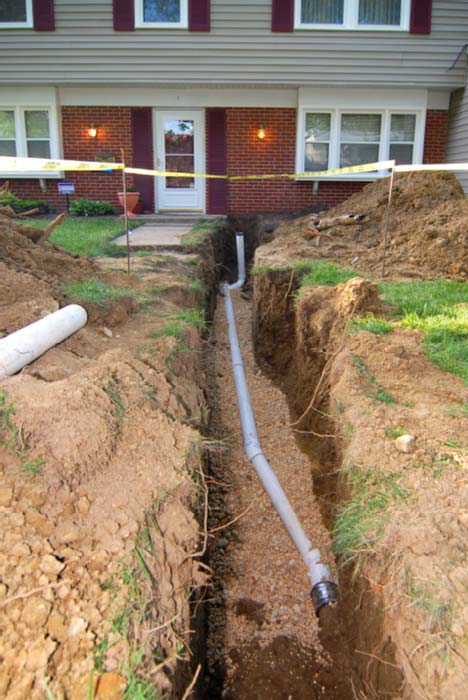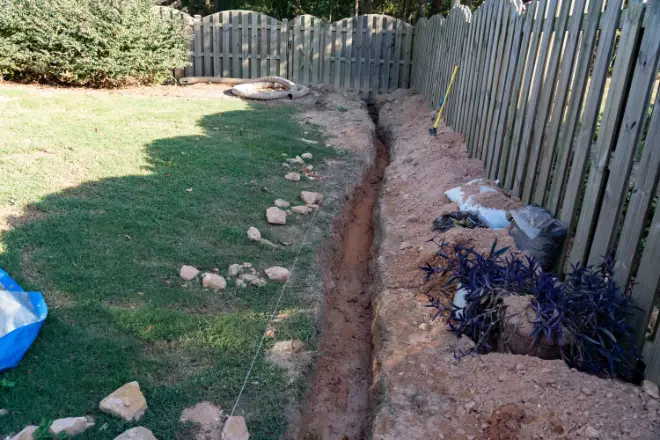Protect Your Building from Excess Water Using a Customized French Drain System
Wiki Article
Comprehending the Importance of a Sewage-disposal Tank French Drain for Effective Wastewater Management
The combination of a septic container French drain system plays an essential role in reliable wastewater management, yet its relevance is often overlooked. Comprehending the technicians and advantages of such a system can illuminate its crucial duty in avoiding dirt saturation and boosting groundwater high quality.What Is a Septic Storage Tank French Drain?
A sewage-disposal tank French drain is a customized drainage system designed to manage wastewater and prevent flooding in areas where standard drain methods might be insufficient. This system integrates the capabilities of a conventional septic container with a French drain, enabling reliable wastewater treatment and effective water diversion.

Created utilizing perforated pipes stocked crushed rock trenches, a French drainpipe helps with the movement of water far from critical areas. It permits the infiltration of excess water into the bordering soil, advertising reliable drain while securing the septic tank's stability. The mix of these two systems is particularly valuable in areas with heavy rains or bad drainage, making certain the long life and capability of wastewater management systems while guarding public wellness and the setting.

How It Functions in Wastewater Management
In wastewater administration, the integration of a sewage-disposal tank and French drainpipe plays a vital duty in making sure effective therapy and disposal of sewer. The septic system offers as the first line of defense, where wastewater undergoes preliminary treatment via sedimentation and anaerobic digestion. Solids clear up at the base, creating sludge, while lighter products, such as grease and oils, float to the top, developing a residue layer. This procedure decreases the natural lots of the wastewater prior to it moves forward.Once the wastewater is clarified, it moves right into the French drain system, which is made to help with additional therapy and secure dispersal. The French drain includes perforated pipelines hidden in gravel or stone, enabling cured effluent to percolate into the bordering dirt. This all-natural filtration procedure aids in the elimination of nutrients and pathogens, promoting groundwater recharge and reducing the danger of surface area contamination.
With each other, the septic system and French drainpipe develop a sustainable technique to wastewater monitoring, lessening environmental impact while making certain conformity with health guidelines. This integrated system not only shields public health and wellness however likewise maintains the integrity of regional ecosystems.
Advantages of a French Drain System

The French drainpipe system provides many advantages that improve both wastewater administration read the article and environmental defense. Mainly, it effectively redirects water away from critical locations, decreasing the danger of flooding and dirt saturation that can compromise septic systems. This aggressive drainage option helps maintain the stability of the sewage-disposal tank by stopping excess dampness, which can lead to system failing.
Additionally, an appropriately mounted French drainpipe minimizes the potential for groundwater contamination. By channeling wastewater far from the residential property, it minimizes the possibility of toxins entering regional water resources, thus guarding public health and wellness and preserving environmental balance. The system also improves the visual appeals and capability of exterior spaces by preventing water build-up, which can produce unsightly puddles or muddy locations.
Moreover, French drains call for reasonably low upkeep compared to various other drain services, making them a cost-effective long-lasting investment. Their convenience permits them to be used in various landscapes, accommodating both residential and business residential properties. Ultimately, the benefits of a French drainpipe system expand past instant drain requirements, contributing to lasting wastewater monitoring methods and advertising ecological stewardship.
Usual Issues Without a French Drainpipe
Ignoring the installment of a French drainpipe can result in significant difficulties in managing water flow and preserving soil stability. One of the key issues is the accumulation of excess surface area water, which can create pooling or swamping in lawns, particularly after visit this web-site hefty rains. This stagnancy can saturate the dirt, leading to disintegration and endangering the foundation of nearby structures.Moreover, without a French drainpipe, groundwater can improperly penetrate septic systems, boosting the risk of system failure. The resulting backup can bring about undesirable smells, wellness risks, and costly repairs. Poor drain can additionally promote the development of mold and mildew and mildew, which can negatively impact indoor air high quality and posture wellness threats to passengers.
Eventually, the absence of a French drainpipe can result in an array of structural and environmental issues that necessitate substantial intervention and expense to correct. Executing a French drainpipe system is crucial for effective wastewater administration and home security.
Maintenance Tips for Homeowners
Routine maintenance of a French drainpipe is necessary to guarantee its ideal efficiency and long life. House owners must regularly inspect the drain for any indicators of blockage or damages. This includes monitoring for debris accumulation, which can hamper water flow. Think about using a high-pressure water jet to clear the drainpipe. if debris is present.Additionally, it is essential to maintain the location around the French drainpipe without debris, such as leaves, soil, and other natural matter. This will prevent obstructing and permit effective water drainage. Frequently trimming plants and growing far from the drain can additionally mitigate root breach.
Additionally, house owners need to check the performance of their French drainpipe after heavy rains. Observing exactly how well water is routed away from the septic tank can give understandings into its performance. If pooling water is noted, it might show a demand for expert assessment.
Finally, take into consideration scheduling routine specialist inspections to evaluate the total condition of the drainpipe. Such positive actions will certainly aid keep the efficiency of your French drainpipe and make sure efficient wastewater administration for many years to come.
Verdict
In conclusion, the septic container French drain system plays an essential duty in effective Related Site wastewater monitoring by making certain correct therapy of sewage and reliable water diversion. Overall, the septic container French drain represents a lasting service that benefits both industrial and household buildings across different landscapes.The assimilation of a septic storage tank French drain system plays a pivotal role in effective wastewater administration, yet its relevance is typically neglected. Eventually, the benefits of a French drain system extend beyond instant drainage demands, adding to sustainable wastewater monitoring techniques and advertising ecological stewardship.
Additionally, without a French drain, groundwater can poorly penetrate septic systems, raising the risk of system failing - French Drain System. Implementing a French drainpipe system is important for efficient wastewater management and residential property security
In verdict, the septic tank French drain system plays an important role in efficient wastewater monitoring by ensuring correct treatment of sewer and effective water diversion.
Report this wiki page